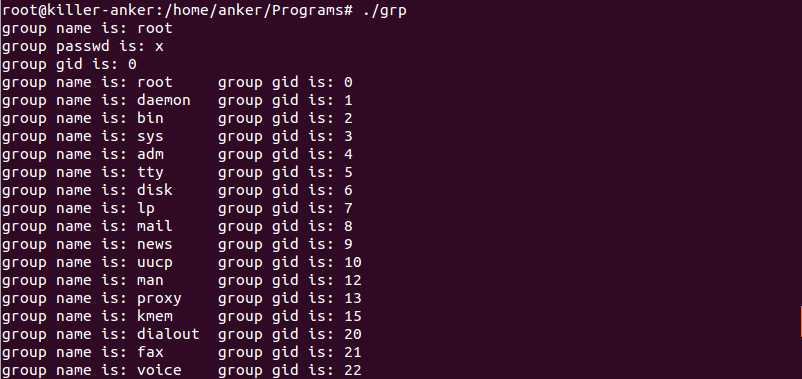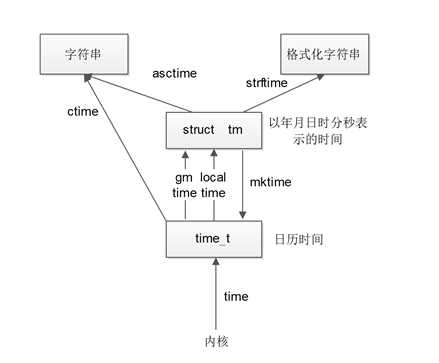Unix環境高級編程(四)數據系統文件和信息
本章主要介紹了Unix系統的正常運行要使用的與系統有關的數據文件和信息。如:口令文件,陰影文件、組文件、附加組、系統標識、時間和日期歷程。
口令文件,即Unix系統用戶數據庫,存儲在/etc/passwd中,是一個ASCII文件,包含的字段信息在<pwd.h>定義的passwd數據結構中。
struct passwd {
char *pw_name; /* username */
char *pw_passwd; /* user password */
uid_t pw_uid; /* user ID */
gid_t pw_gid; /* group ID */
char *pw_gecos; /* user information */
char *pw_dir; /* home directory */
char *pw_shell; /* shell program */
};
獲取口令文件函數,分別是根據用戶ID和用戶名。
struct passwd *getpwuid(uid_t uid); //根據用戶ID
struct passwd *getpwnam(const char *name); //根據用戶名
查看整個口令文件,需要對口令文件進行遍歷。有如下函數:
struct passwd *getpwent(void); //返回口令文件中的下一個記錄項
void setpwent(void); //反繞文件,從文件頭開始
void endpwent(void); //關閉文件
可以用getpwent來實現getpwuid和getpwnam函數。寫個程序查看root用戶的相關信息及查看口令文件中所有用戶的用戶名,程序如下:
1 #include <stdio.h>
2 #include <stdlib.h>
3 #include <unistd.h>
4 #include <pwd.h>
5
6 int main()
7 {
8 struct passwd *ppwd;
9 struct passwd *ptr;
10 //獲取root用戶信息
11 ppwd = getpwnam("root");
12 if(ppwd == NULL)
13 {
14 perror("getpwnam() error");
15 exit(-1);
16 }
17 printf("root user information as follow:\n");
18 printf("user_name is: %s\n",ppwd->pw_name);
19 printf("user_passwd is: %s\n",ppwd->pw_passwd);
20 printf("user_uid is: %d\n",ppwd->pw_uid);
21 printf("user_gid is: %d\n",ppwd->pw_gid);
22 printf("user_gecos is: %s\n",ppwd->pw_gecos);
23 printf("user_dir is: %s\n",ppwd->pw_dir);
24 printf("user_shell is: %s\n",ppwd->pw_shell);
25 printf("*****************************\n");
26 //反轉口令文件,從文件頭開始
27 setpwent();
28 printf("Print all user name:\n");
29 //遍歷讀取口令文件
30 while((ptr = getpwent())!= NULL)
31 {
32 printf("%s\t",ptr->pw_name);
33 }
34 putchar(‘\n‘);
35 //關閉口令文件
36 endpwent();
37 return 0;
38 }
測試結果如下:

陰影文件,存放加密口令,至少包含有用戶名和加密口令。類似於口令文件,Unix在<shadow.h>都文件中針對陰影文件也提供類似的操作函數,但是只有超級用戶(root)才能調用訪問陰影文件的函數。陰影文件位於/etc/shadow文件中,文件結構及操作函數如下:
struct spwd {
char *sp_namp; /* Login name */
char *sp_pwdp; /* Encrypted password */
long sp_lstchg; /* Date of last change (measured in days since 1970-01-01 00:00:00 +0000 (UTC)) */
long sp_min; /* Min # of days between changes */
long sp_max; /* Max # of days between changes */
long sp_warn; /* # of days before password expire to warn user to change it */
long sp_inact; /* # of days after password expire until account is disabled */
long sp_expire; /* Date when account expires (measured in days since 1970-01-01 00:00:00 +0000 (UTC)) */
unsigned long sp_flag; /* Reserved */
};
struct spwd *getspnam(const char *name);
struct spwd *getspent(void);
void setspent(void);
void endspent(void);
寫個程序查看root用戶的加密口令及所有用戶的用戶名及加密口令如下:
1 #include <stdio.h>
2 #include <stdlib.h>
3 #include <unistd.h>
4 #include <shadow.h>
5
6 int main()
7 {
8 struct spwd *pspwd;
9 struct passwd *ptr;
10 pspwd = getspnam("root");
11 if(pspwd == NULL)
12 {
13 perror("getspnam() error");
14 exit(-1);
15 }
16 printf("root user information as follow:\n");
17 printf("user_name is: %s\n",pspwd->sp_namp);
18 printf("user_passwd is: %s\n",pspwd->sp_pwdp);
19 printf("*****************************\n");
20 setspent();
21 while((pspwd = getspent()) != NULL)
22 {
23 printf("user_name is: %s\n",pspwd->sp_namp);
24 printf("user_passwd is: %s\n",pspwd->sp_pwdp);
25 }
26 endspent();
27 return 0;
28 }
只能在超級用戶下運行此程序,在普用戶下提升權限不夠。執行結果如下所示:

組文件,即組數據庫文件,存儲在/etc/group中,結構及操作函數包含在<grp.h>頭文件中。具體結構和操作函數如下:
struct group {
char *gr_name; /* group name */
char *gr_passwd; /* group password */
gid_t gr_gid; /* group ID */
char **gr_mem; /* group members */
};
struct group *getgrnam(const char *name);
struct group *getgrgid(gid_t gid);
搜索整個文件組函數:
struct group *getgrent(void);
void setgrent(void);
void endgrent(void);
寫個程序,打印出組id為0的組名稱及遍歷整個組文件,輸出組名稱及組id。程序如下:
1 #include <stdio.h>
2 #include <stdlib.h>
3 #include <unistd.h>
4 #include <grp.h>
5 #include <errno.h>
6
7 int main()
8 {
9 struct group *pgrg;
10 struct group *ptr;
11 gid_t gid = 0;
12 char *username = NULL;
13 //根據gid進行查詢
14 pgrg = getgrgid(gid);
15 if(pgrg == NULL)
16 {
17 perror("getgrgid() error");
18 exit(-1);
19 }
20 printf("group name is: %s\n",pgrg->gr_name);
21 printf("group passwd is: %s\n",pgrg->gr_passwd);
22 printf("group gid is: %d\n",pgrg->gr_gid);
23 setgrent();
24 //遍歷整個組文件
25 while((ptr = getgrent()) != NULL)
26 {
27 printf("group name is: %s\t",ptr->gr_name);
28 printf("group gid is: %d\n",ptr->gr_gid);
29 }
30 endgrent();
31 return 0;
32 }
程序執行結果如下所示:

附加組,一個用戶可以屬於多個組,這樣可以參加多項工作,優點是不必顯式地經常更改組。用戶登錄時候,系統按照口令文件記錄項中的數值組ID,賦給實際組ID,可以在任何時候通過newgrp更改組ID。為了獲取和設置附加組ID,提供操作函數如下:
int getgroups(int size, gid_t list[]); //將各個附加組ID填寫到數組grouplist中
int setgroups(size_t size, const gid_t *list); //由超級用戶調用,以便為調用進程設置附加組ID表
int initgroups(const char *user, gid_t group); //調用setgroups,確定其組的成員關系
其他數據文件 除了口令文件和組文件外,Linux也使用很多其他文件,一般情況下,這些文件都至少支持三個函數:
(1)get函數:讀文件中的下一個記錄項。
(2)set函數:將文件偏移量設置到文件起始處。
(3)end函數:關閉系統文件。
如果該文件支持關鍵字檢索,例如口令文件支持基於用戶名和用戶ID的檢索,因此實現了接口getpwnam和getpwuid函數,就會支持相應的函數。
| 說明 | 數據文件 | 頭文件 | 結構 | 附加的關鍵字查找函數 |
| 口令 | /etc/passwd | <pwd.h> | passwd | getpwnam 、getpwuid |
| 組 | /etc/group | <grp.h> | group | getpwnam、getpwuid |
| 陰影 | /etc/shadow | <shadow.h> | spwd | getspnam |
| 主機 | /etc/hosts | <netdb.h> | hostent | gethostbyname、gethostbyaddr |
| 網絡 | /etc/networks | <netdb.h> | netent | getnetbyname、getnetbyaddr |
| 協議 | /etc/protocols | <netdb.h> | protoent | getprotobyname、getprotobyaddr |
| 服務 | /etc/services | <netdb.h> | servent | getservbyname、getservbyad |
系統標識,uname函數返回與當前主機和操作系統有關的信息,函數字在<sys/utsname.h>頭文件中定義。utsname結構信息和操作函數如下:
struct utsname {
char sysname[]; /* Operating system name (e.g., "Linux") */
char nodename[]; /* Name within "some implementation-defined network" */
char release[]; /* OS release (e.g., "2.6.28") */
char version[]; /* OS version */
char machine[]; /* Hardware identifier */
#ifdef _GNU_SOURCE
char domainname[]; /* NIS or YP domain name */
#endif
};
int uname(struct utsname *buf);
寫個程序獲取本機當前主機和操作系統信息,程序如下:
1 #include <stdio.h>
2 #include <stdlib.h>
3 #include <unistd.h>
4 #include <sys/utsname.h>
5 #include <errno.h>
6
7 int main()
8 {
9 struct utsname name;
10 if(uname(&name) == -1)
11 {
12 perror("uname() error");
13 exit(-1);
14 }
15 printf("system name is: %s\n",name.sysname);
16 printf("node name is: %s\n",name.nodename);
17 printf("release is: %s\n",name.release);
18 printf("version is: %s\n",name.version);
19 printf("machine is: %s\n",name.machine);
20 return 0;
21 }
程序執行結果如下:

時間和日期,Unix內核提供的基本時間服務是計算自國際標準時間公元1970年1月1日00:00:00以來經過的秒數,基本數據類型是time_t,稱為日歷時間,包括時間和日期,將時間和日期作為一個量值進行保存。類型定義如下:
#ifndef __TIME_T #define __TIME_T /* 避免重復定義 time_t */ typedef long time_t; /* 時間值time_t 為長整型的別名*/ #endif 相關操作函數有: #include <time.h>time_t time(time_t *t); //返回當前時間及日期
#include <sys/time.h>
int gettimeofday(struct timeval *tv, struct timezone *tz); //相比time提供更高的分辨率,微妙級
int settimeofday(const struct timeval *tv, const struct timezone *tz);
struct timeval {
time_t tv_sec; /* seconds */
suseconds_t tv_usec; /* microseconds */
};
struct timezone {
int tz_minuteswest; /* minutes west of Greenwich */
int tz_dsttime; /* type of DST correction */
};
取得了這種以秒計的整型時間後,通常調用另外一個時間函數將其轉化為人們可讀的時間和日期。時間的結構及操作函數有:
struct tm {
int tm_sec; /* seconds */
int tm_min; /* minutes */
int tm_hour; /* hours */
int tm_mday; /* day of the month */
int tm_mon; /* month */
int tm_year; /* year */
int tm_wday; /* day of the week */
int tm_yday; /* day in the year */
int tm_isdst; /* daylight saving time */
};
char *asctime(const struct tm *tm);
char *ctime(const time_t *timep);
struct tm *gmtime(const time_t *timep); //轉換為國際標準時間
struct tm *localtime(const time_t *timep); //轉換為本地實際
time_t mktime(struct tm *tm);
size_t strftime(char *s, size_t max, const char *format,const struct tm *tm); //對tm進行格式化輸出到一個字符串
函數之間的關系如下圖:

寫一個程序鞏固時間函數,程序如下:
1 #include <stdio.h>
2 #include <stdlib.h>
3 #include <unistd.h>
4 #include <time.h>
5 #include <errno.h>
6 #include <string.h>
7
8 int main()
9 {
10 time_t now;
11 struct tm *ptime;
12 char *ptstr;
13 char timebuf[100];
14 memset(timebuf,0,100);
15 //獲取時間,秒數
16 now = time(&now);
17 printf("Global time is:\n");
18 //轉化為國際時間
19 ptime = gmtime(&now);
20 ptime->tm_year += 1900;
21 ptime->tm_mon += 1;
22 printf("%d-%d-%d %d:%d:%d\n",ptime->tm_year,ptime->tm_mon,ptime->tm_mday,
23 ptime->tm_hour,ptime->tm_min,ptime->tm_sec);
24 printf("Local time is:\n");
25 //轉化為本地時間
26 ptime = localtime(&now);
27 ptime->tm_year += 1900;
28 ptime->tm_mon += 1;
29 printf("%d-%d-%d %d:%d:%d\n",ptime->tm_year,ptime->tm_mon,ptime->tm_mday,
30 ptime->tm_hour,ptime->tm_min,ptime->tm_sec);
31 //將tm結構轉換為字符串
32 ptstr = asctime(ptime);
33 printf("tm time stirng is: %s",ptstr);
34 //將time_t類型轉換為字符串
35 ptstr = ctime(&now);
36 printf("time_t time string is: %s",ptstr);
37 //date 格式化輸出時間
38 strftime(timebuf,100,"%YYear %mMonth %dDay %A %X",ptime);
39 printf("time buf is:%s\n",timebuf);
40 return 0;
41 }
程序執行結果如下所示:

總結:加深對Unix的系統數據文件及時間日期的認識,能夠調用系統函數獲取系統相關數據。
Unix環境高級編程(四)數據系統文件和信息
